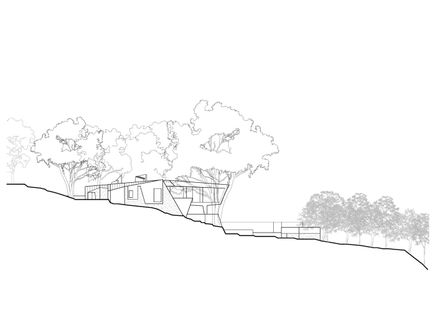
Castle Cove House
ARCHITECTS
TERROIR
LEAD ARCHITECTS
Gerard Reinmuth, Chris Rogers, Scott Balmforth
MANUFACTURERS
AutoDesk, Vitrocsa, ATLITE, Apparatus Studio, CDK stone, Modular Lighting Instruments, REHAU, elZinc, Earp Brothers, Euroluce, Greene Fire, Internal, Panles, Regipol, Veneer Panels, Vistrosca
ESD ADVICE & THERMAL MODELLING
Beckham Price - SBE, SBE, Beckham Price
PLUMBING CONTRACTOR
Innerwest Plumbing
INTERIORS
McNabb Design, TERROIR, Pascale Gomes-McNabb Design, Pascale Gomes
INTERIOR STYLING
McNabb Design, Pascale Gomes-McNabb Design, Pascale Gomes
JOINERY
Rintoul
LIGHTING DESIGN
McNabb Design, TERROIR, Pascale Gomes-McNabb Design, Pascale Gomes
ELECTRICAL CONTRACTOR
CandSnee
BUILDER EXTERIOR AND INTERIOR FINISHING
Callic Constructions, Ed Callanan
STRUCTURAL ENGINEER
SDA Structures
CONCRETE WORKS
GD Concrete
CONCRETER
GD Concrete
DESIGN TEAM
Robert Beson, Sarah Benton, Josh Lynch, Amanda Clarke, Alex Moore, Kirrill Grigarin
BUILDER CONCRETE STRUCTURE
Olding Constructions
HYDRAULIC ENGINEER DESIGN
Warren Smith & Partners
METALWORK & STRUCTURAL STEEL CONTRACTOR
Salken Engineering
PHOTOGRAPHS
Brett Boardman Photography
AREA
510 m²
YEAR
2018
LOCATION
Castle Cove, Australia
CATEGORY
Houses
Text description provided by architect.
The history of the single-family house in Sydney during the last century is one that fuses an evolving approach to our relationship with the landscape with a history of experimentation in residential house design.
These two strands have come together most memorably in the occupation of the steep and often spectacular landscapes around the inner harbour and the modes of habitation made possible in the way these houses relate to their site and Sydney’s benign climate.
This project is sited in one of these classic Sydney contexts, Castle Cove, where steep ravines contain tributaries that flow through angophora bushland down to the harbour.
The sandstone geology is omnipresent and takes many forms, from mighty escarpments to minor ripples in the bedrock.
These landscape tectonics inform the design, where a concrete shell of irregular geometry steps around outcrops and contours, creating an indeterminate form that is distinctively new but also could equally be a strange object ‘unearthed’ in excavation.
Either way, the concrete element reverberates with the site geometry while forming a built escarpment that provides a plateau for habitation.
The concrete escarpment is roofed in a zinc membrane that folds over to form a smaller pocket to the rear containing private rooms.Both materials will patinate over time, moving again from a “new” to “pre-existing” form.
The infrastructural nature of this primary gesture has in its counterpoint the means of occupying the house through a series of crafted timber linings that enableoccupation of this concrete landscape with a spirit and glamour reminiscent of the California’s mid-century houses by John Lautner and others.
The resulting interior spaces connect inhabitants with the monumental and wonderous nature of the landscape yet still provide intimate moments for occupation that are so necessary for everyday life.
These linings are further embellished with a number of steel, brass and mirror inserts that are like devices or instruments that start in the practical requirements of occupation, given their basis in linings, benches, windows and skylights.
The common thread through each instrument is the further diffusion of the concrete container both physically (in fissures and pockets that increase its porosity) and perceptually (through mirrors, skylights passing through all levels, openings that limit acoustic privacy) that serve to mentally expand the scale of the building.
In every case, the instruments serve to intensify the relation between occupants and landscape so directly established by the primary concrete form.
This strong connection to place has also led to passive house strategies embedded in and intertwined through the form of the structure.
The basement acts as a cold sink that allows for cool air to be constantly drawn through the main living spaces via floor vents and operable skylights purposely tilted north to draw heat and assist in the convection process.
Combined with cross ventilation, generous overhangs, thermal mass, double glazing with internal and external blinds and a hydronic under floor heating system these passive strategies have produced a thermally stable environment for the occupants that requires little active power consumption.




















